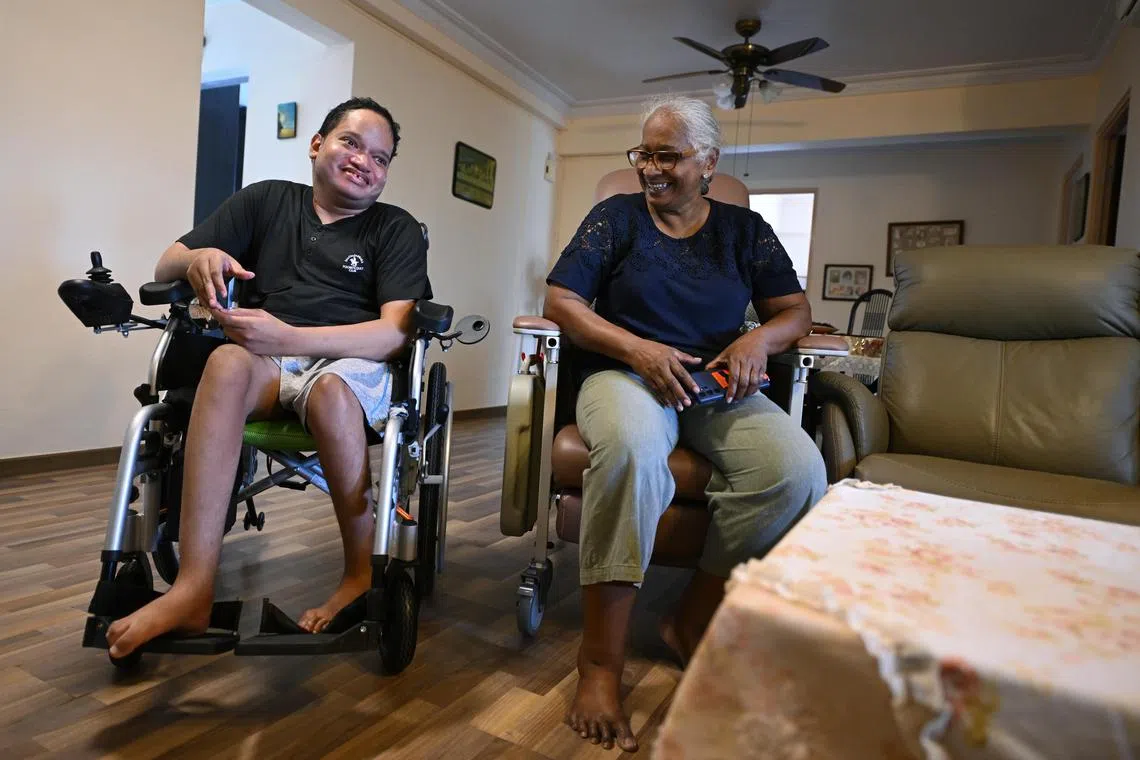Mother not aware that son was entitled to CareShield Life payouts
Sign up now: Get ST's newsletters delivered to your inbox

Madam Sundrampillai Indrani found out her son, Mr Gideon Joseph, was eligible for CareShield Life payouts only in 2022.
ST PHOTO: NG SOR LUAN
Follow topic:
SINGAPORE – For Madam Sundrampillai Indrani, 68, getting $600 a month in payouts from CareShield Life came as a vast relief. The part-time healthcare worker has been struggling to care for her son, Mr Gideon Joseph, 33, who has had cerebral palsy since birth.
He suffered from swelling of the brain and had to have a shunt put in when he was 11 days old. The shunt is still there, so is the damage to his brain.
Apart from his physical disability which keeps him wheelchair-bound, his memory is poor, and he is unable to read or write.
In spite of his obvious disabilities, Mr Joseph almost fell through the cracks in the system. That was because Madam Indrani was not aware of the scheme, or that he qualifies for the long-term disability insurance.
When CareShield Life was launched in October 2020,
Once the first premium is paid from their MediSave account, those who are unable to perform at least three of six activities of daily living – washing, dressing, feeding, going to the toilet, walking or moving around, and transferring from a bed to a chair or wheelchair – will be able to receive a monthly payout for the rest of their lives.
To receive the payout, an application has to be made by the individual or his caregiver.
It was only in 2022, when Madam Indrani was at her wits’ end trying to make ends meet, that her sister-in-law suggested that she approach Tan Tock Seng Hospital, where her son goes for treatment when necessary, to see if there was any financial help available.
She was told that Mr Joseph should qualify for CareShield Life payouts. The Agency for Integrated Care (AIC) staff there helped her with the application, which was approved in six days.
She started receiving $624 a month from September 2022 – 23 months after he could have begun getting payouts. Instead, he continued paying premiums through his and his mother’s MediSave accounts.
As his caregiver, Madam Indrani has also been receiving the means-tested Home Caregiving Grant since August 2022. Since March 2023, the amount she gets was enhanced from $200 to $400 a month.
Madam Indrani said the extra $1,000 a month is a big help.
She works two hours a day, seven days a week, as a part-time caregiver, doing things like helping others shower, or accompanying them to a doctor’s appointment or dialysis.
Neither her 76-year-old husband nor her eldest son, who is 34 and has suffered from uncontrolled epilepsy since he was 18, is working. Only her youngest son, 29, is employed. He gives her $700 a month.
But expenses for Mr Joseph are high. He is unable to pass urine, so a catheter needs to be inserted at least twice a day. But because of leaks, he also needs diapers. His skin is sensitive and requires Eucerin soap, which helps with allergies. These cost her about $400 a month.
He also needs medication from the polyclinic every six months, including for diabetes and fits. Once Madam Indrani’s annual MediSave cap for outpatient treatment is reached, the rest has to be paid for in cash.
Earlier in 2023, her sister-in-law urged her to try to see if CareShield Life would pay her for the 23 months that Mr Joseph had missed getting the payout.
Again with help from the AIC, she submitted an appeal and received payouts backdated to October 2020, which worked out to about $14,000.
As the start date of the payout is now 2020, the monthly amount he gets was adjusted to $600. Although CareShield Life payouts have gone up every year, the amount a recipient gets is fixed at the amount of the first payout.
Aware of the benefits of the scheme, Madam Indrani herself has signed up for CareShield Life. She is among 105,000 people born before 1970 who have voluntarily signed up.
To encourage people in their 40s and older to join the scheme, the Government is offering an age-based incentive ranging from $500 to $4,000 if they join by the end of 2023.
Madam Indrani received the maximum $4,000 participation incentive. She also qualifies for the means-tested premium subsidies of up to 30 per cent that help people from middle- and lower-income families.
She is so relieved that the payouts for her son will be for life. She said: “After I am gone, at least there will still be this money for his care.”


